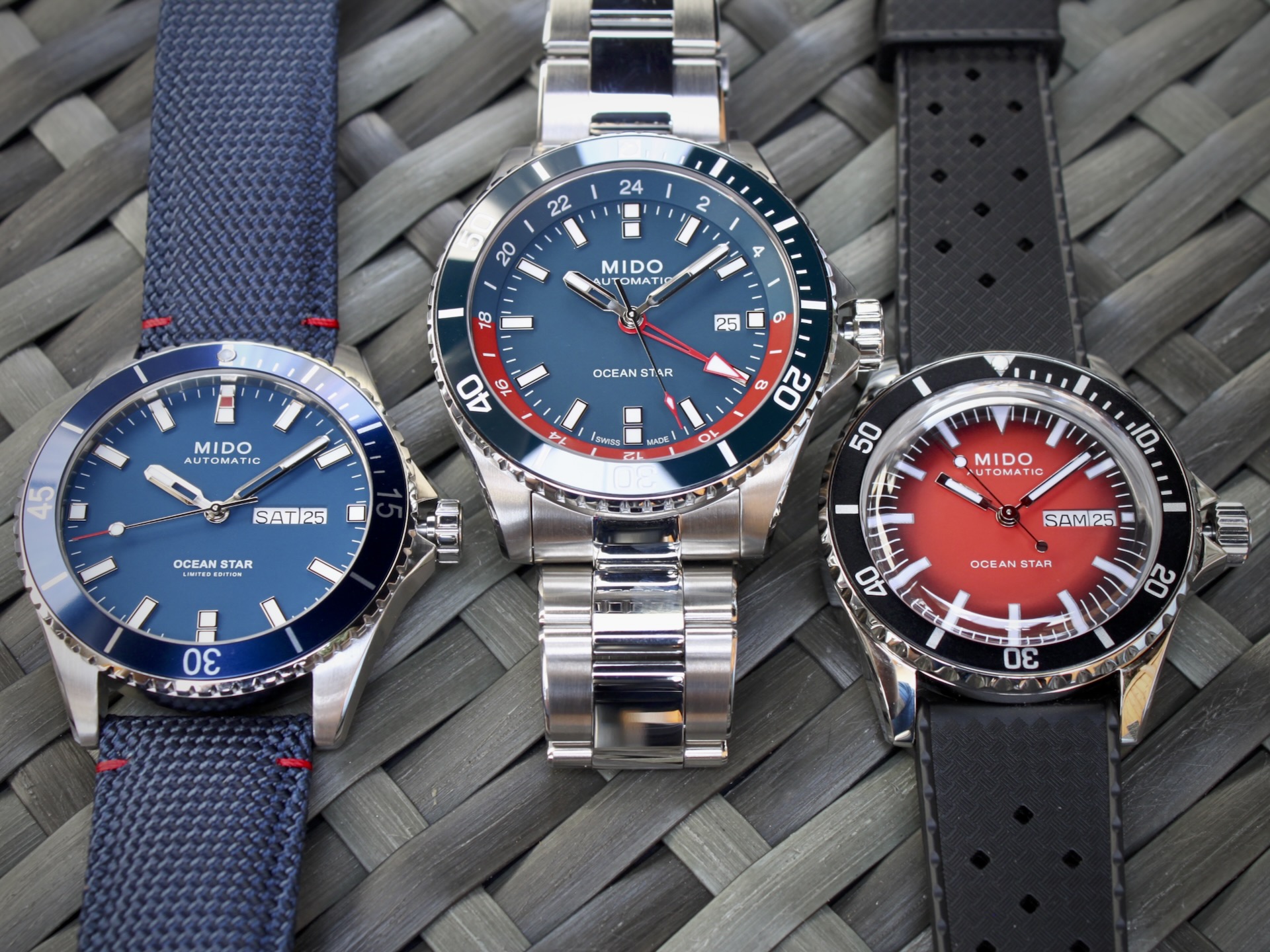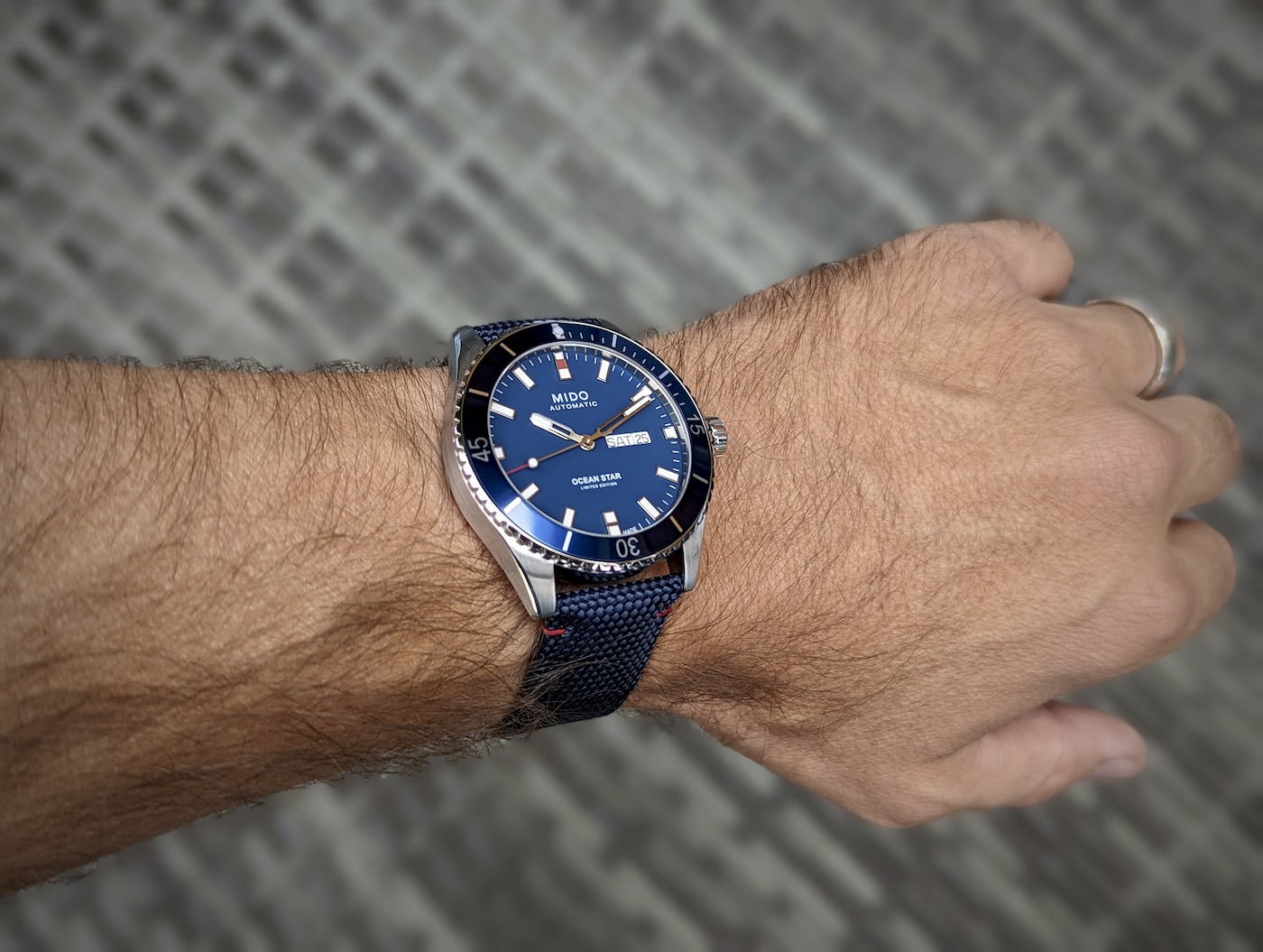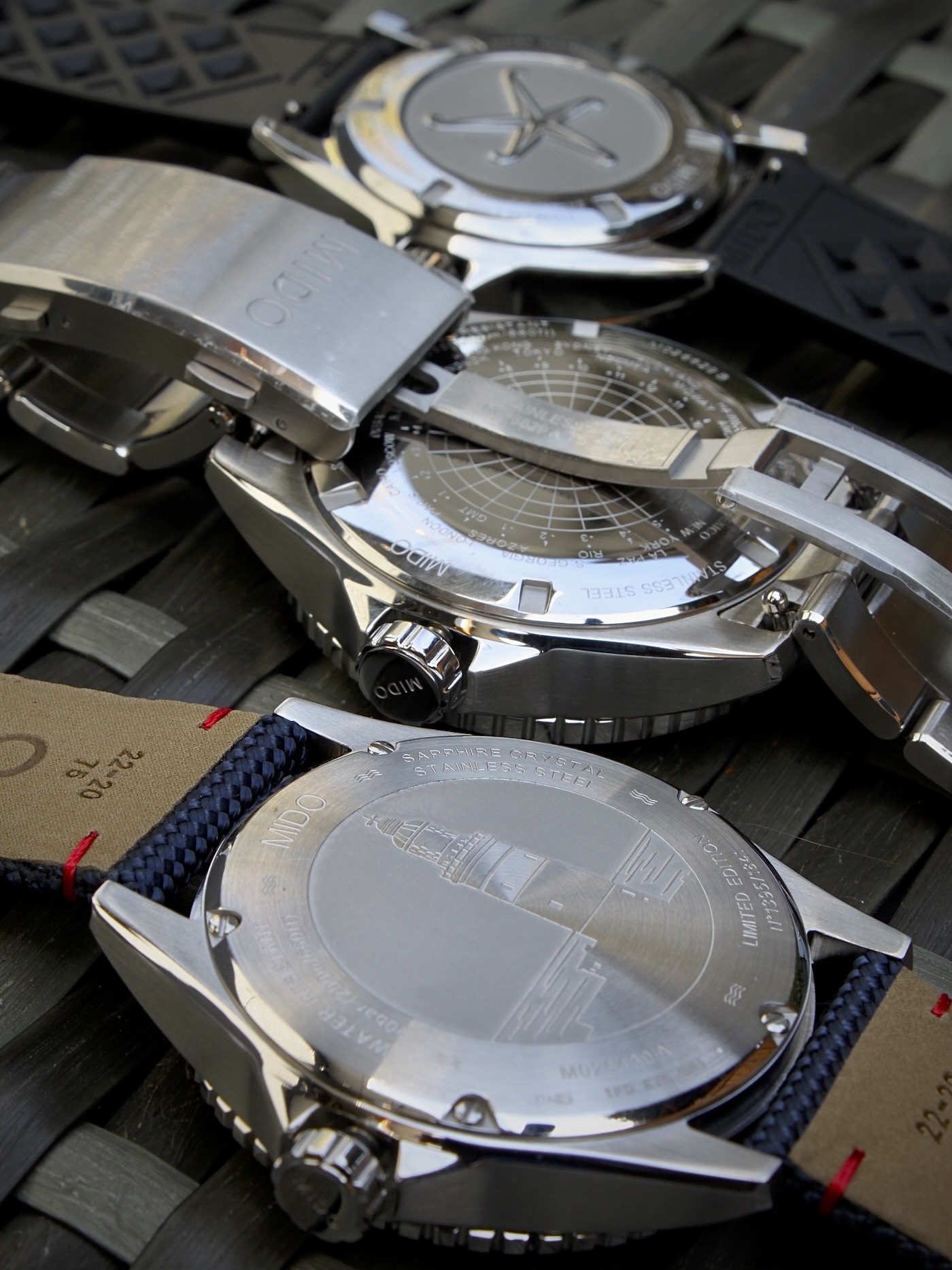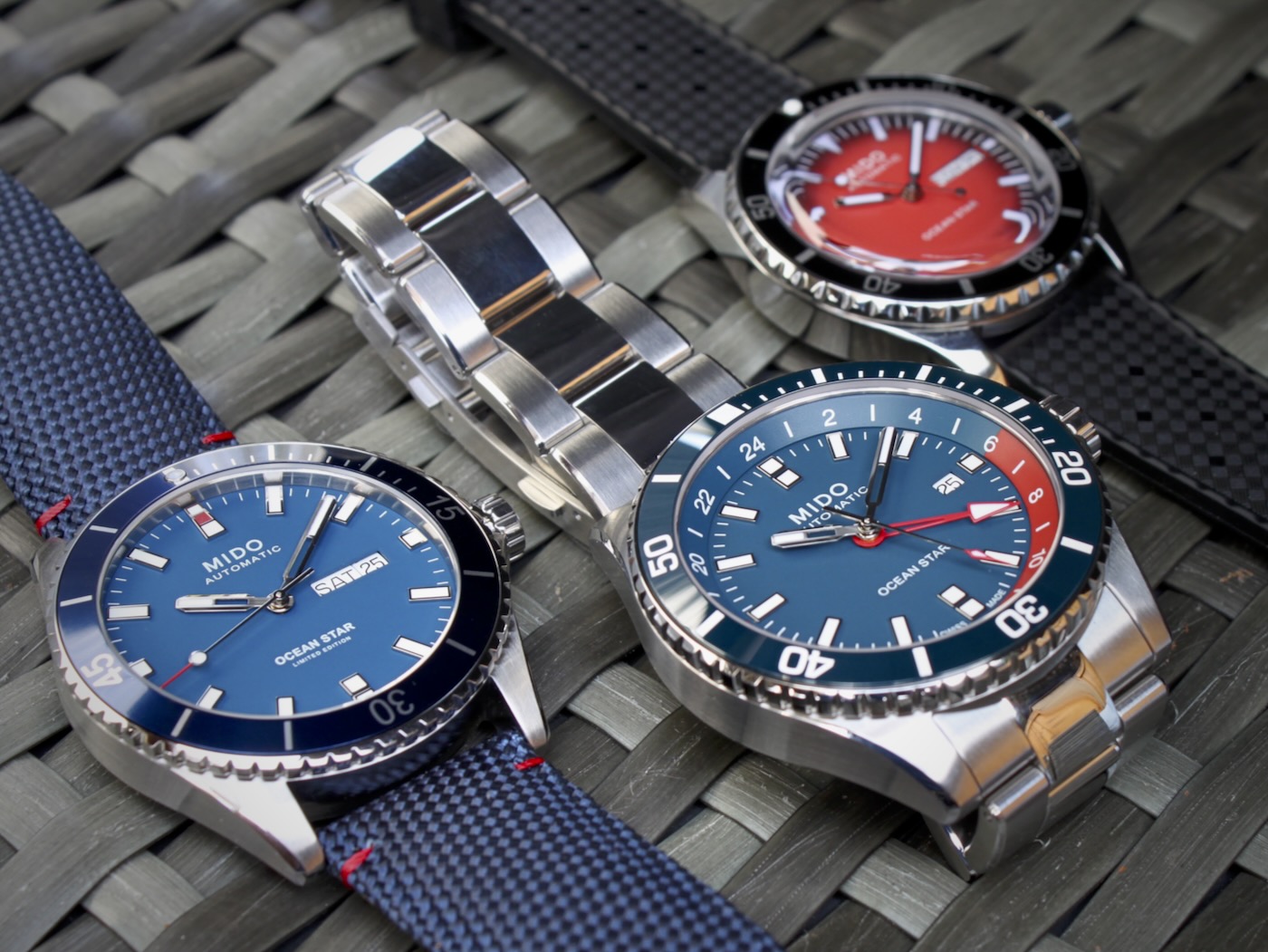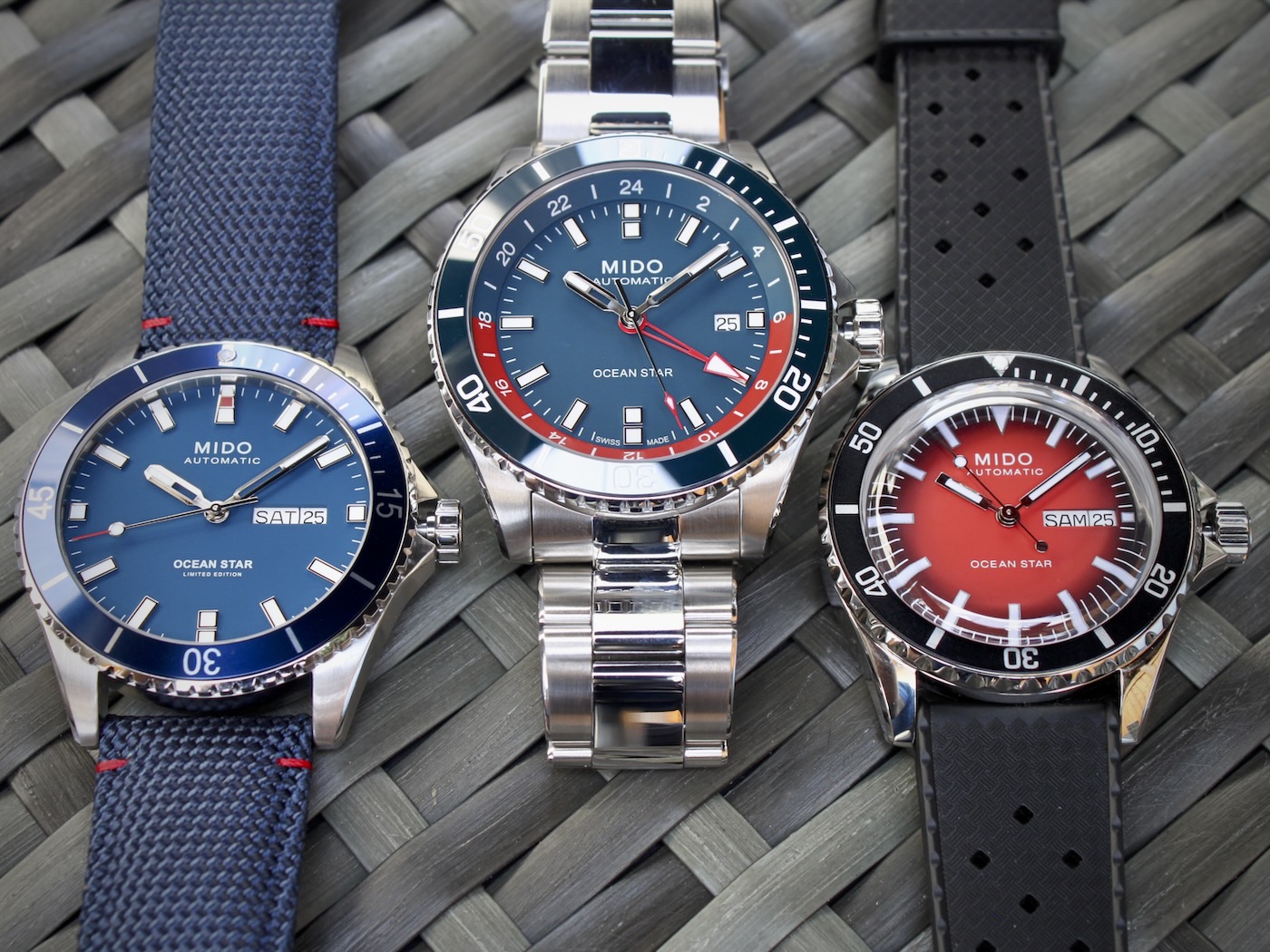 Mido is one of those brands in Swatch Group that has flown a bit under the radar, at least for North American buyers, but that’s been changing in recent years as more people discover the brand and its vast catalog of watches that tend to provide great value for the dollar. Take a browse through the brand’s website, and Mido has a watch in every major category for seemingly every taste. For those in search of a dive watch, Mido’s Ocean Star line has that genre covered. Consisting of six models in a variety of different colorways and styles, Mido offers a grand total of 29 different Ocean Star models, ranging from modestly sized vintage-styled divers to burly blacked-out chronographs to two-tone GMTs. Mido was kind enough to send us three Ocean Star models, allowing us to get a sense of what the range offers.
Mido is one of those brands in Swatch Group that has flown a bit under the radar, at least for North American buyers, but that’s been changing in recent years as more people discover the brand and its vast catalog of watches that tend to provide great value for the dollar. Take a browse through the brand’s website, and Mido has a watch in every major category for seemingly every taste. For those in search of a dive watch, Mido’s Ocean Star line has that genre covered. Consisting of six models in a variety of different colorways and styles, Mido offers a grand total of 29 different Ocean Star models, ranging from modestly sized vintage-styled divers to burly blacked-out chronographs to two-tone GMTs. Mido was kind enough to send us three Ocean Star models, allowing us to get a sense of what the range offers.
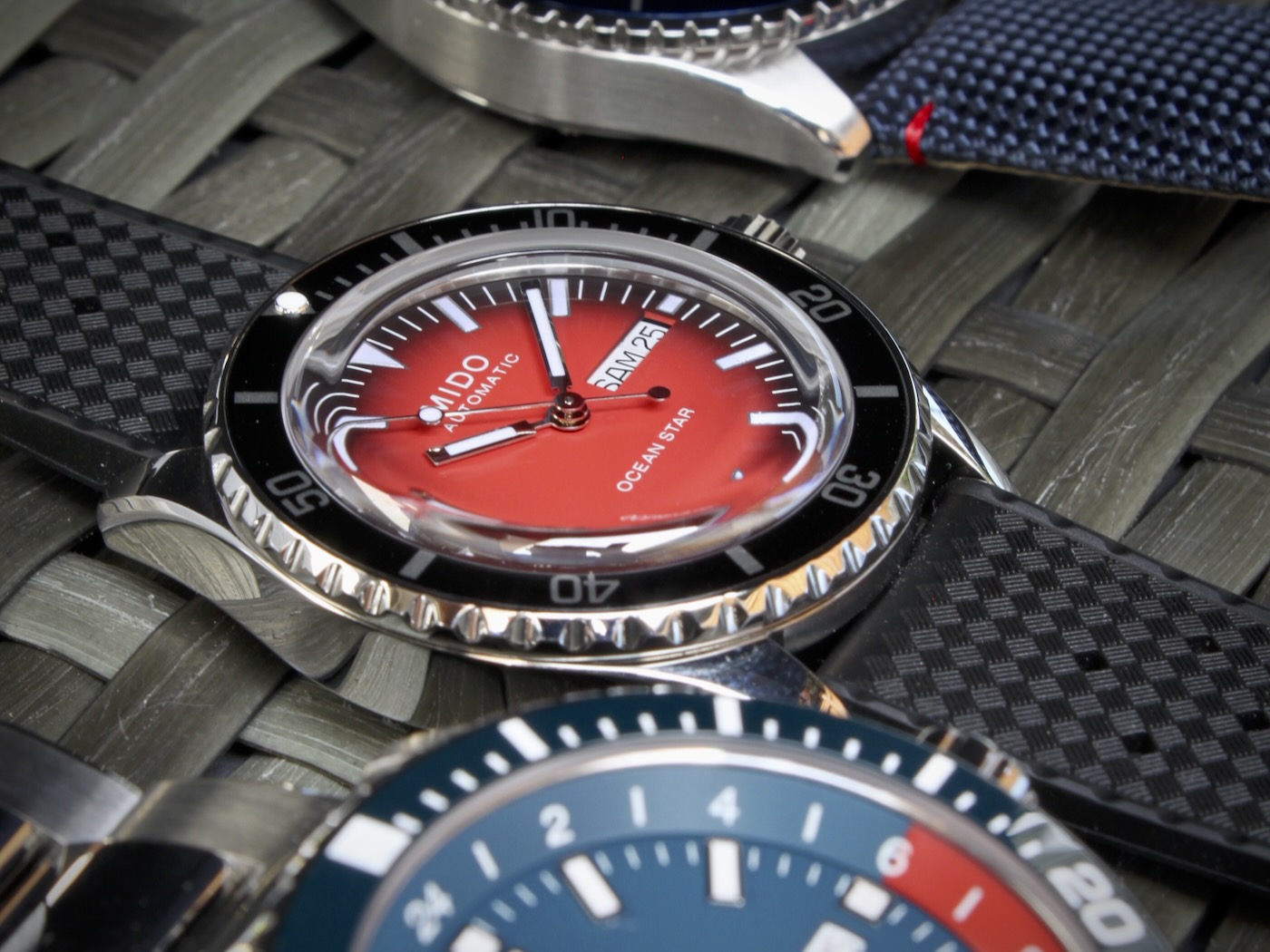 The three watches Mido provided were the vintage-themed Ocean Star Tribute Gradient, the limited-edition Ocean Star 200 20th Anniversary Inspired by Architecture, and, finally, the special edition Ocean Star GMT. At a cursory glance, the watches look quite different, but a closer inspection reveals the familial traits that expose their shared ancestry. It’s like meeting a pair of siblings; sure, one may spend an inordinate amount of time at the gym, while the other is more into beat poetry and vinyl records, but put them together and there’s no mistaking the aquiline noses, hazel eyes, or goofy laugh; they’re clearly family.
The three watches Mido provided were the vintage-themed Ocean Star Tribute Gradient, the limited-edition Ocean Star 200 20th Anniversary Inspired by Architecture, and, finally, the special edition Ocean Star GMT. At a cursory glance, the watches look quite different, but a closer inspection reveals the familial traits that expose their shared ancestry. It’s like meeting a pair of siblings; sure, one may spend an inordinate amount of time at the gym, while the other is more into beat poetry and vinyl records, but put them together and there’s no mistaking the aquiline noses, hazel eyes, or goofy laugh; they’re clearly family.
Mido Ocean Star Tribute Gradient
The smallest watch in the collection, the Tribute Gradient, measures in at 40.5mm in diameter, ~47mm lug-to-lug, and 13.4mm-thick. Keep in mind, however, that the case is topped with a tall, box sapphire crystal, meaning that the watch wears more like a watch that’s 11-12mm thick. Like the rest of the Ocean Star watches reviewed here, the Tribute Gradient has 200m of water resistance. The entire case is smooth and polished, with subtle chamfers on the transitions. While some may recoil at the mention of a full polish case, it really does fit the look and feel of the Tribute Gradient. The only unfortunate aspect of the full polish is on the bezel, where the 120-click bezel becomes a bit slippery and hard to turn.
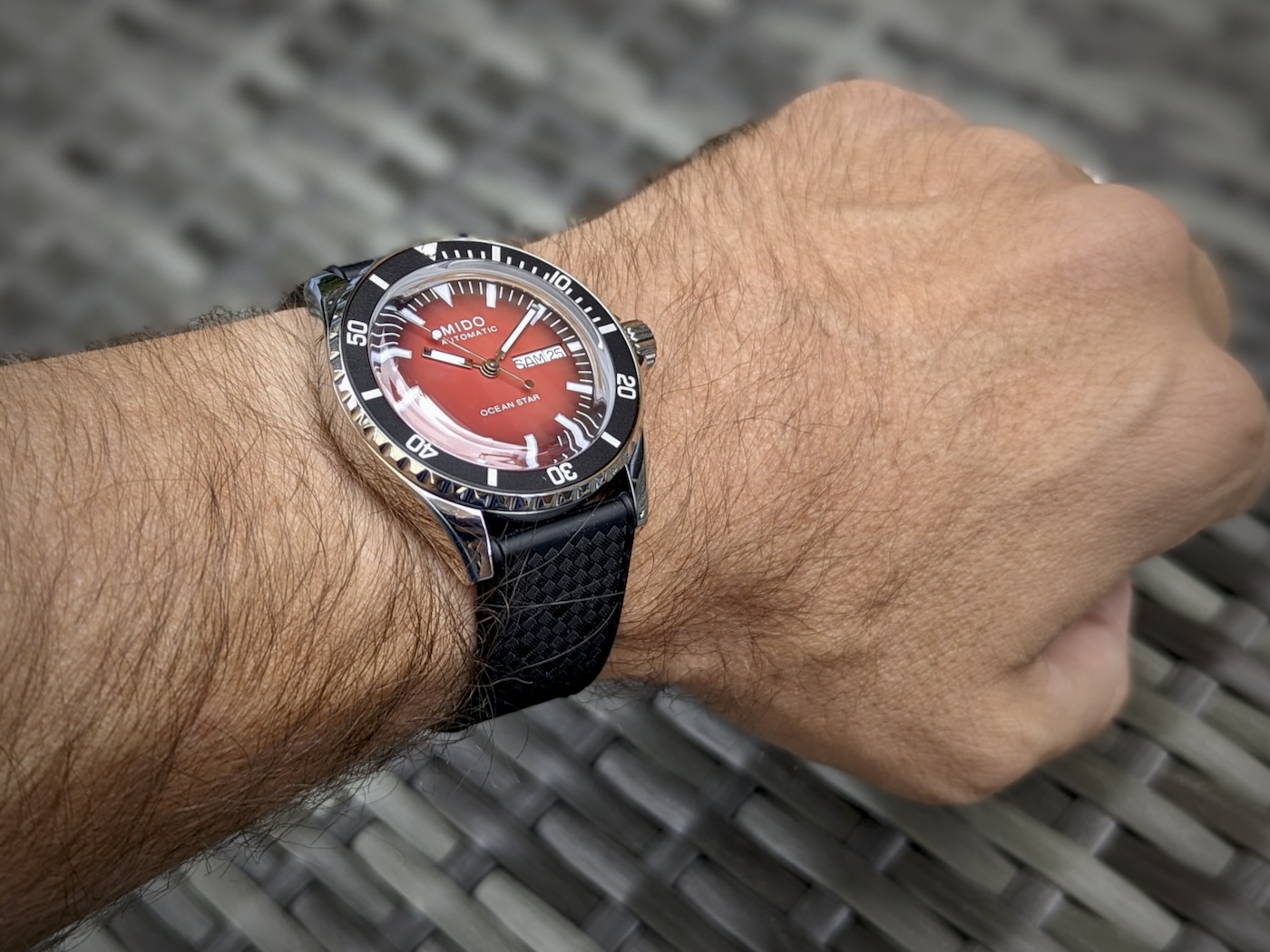 The main talking point of the Tribute Gradient is, of course, the gorgeous, gradient dial. The deep red fades to black when you get to the minutes track and is especially lovely when coupled with the slight distortion from the box crystal. The indices are large and luminous and, though they may look printed, they are actually applied with white surrounds. Mido keeps text on the dial to a minimum, allowing the dial to feel open and clean. That said, one aspect on the dial that’s sure to be divisive is the inclusion of a day/date complication at 3 o’clock, as that complication tends to be a love-it-or-hate-it feature.
The main talking point of the Tribute Gradient is, of course, the gorgeous, gradient dial. The deep red fades to black when you get to the minutes track and is especially lovely when coupled with the slight distortion from the box crystal. The indices are large and luminous and, though they may look printed, they are actually applied with white surrounds. Mido keeps text on the dial to a minimum, allowing the dial to feel open and clean. That said, one aspect on the dial that’s sure to be divisive is the inclusion of a day/date complication at 3 o’clock, as that complication tends to be a love-it-or-hate-it feature.
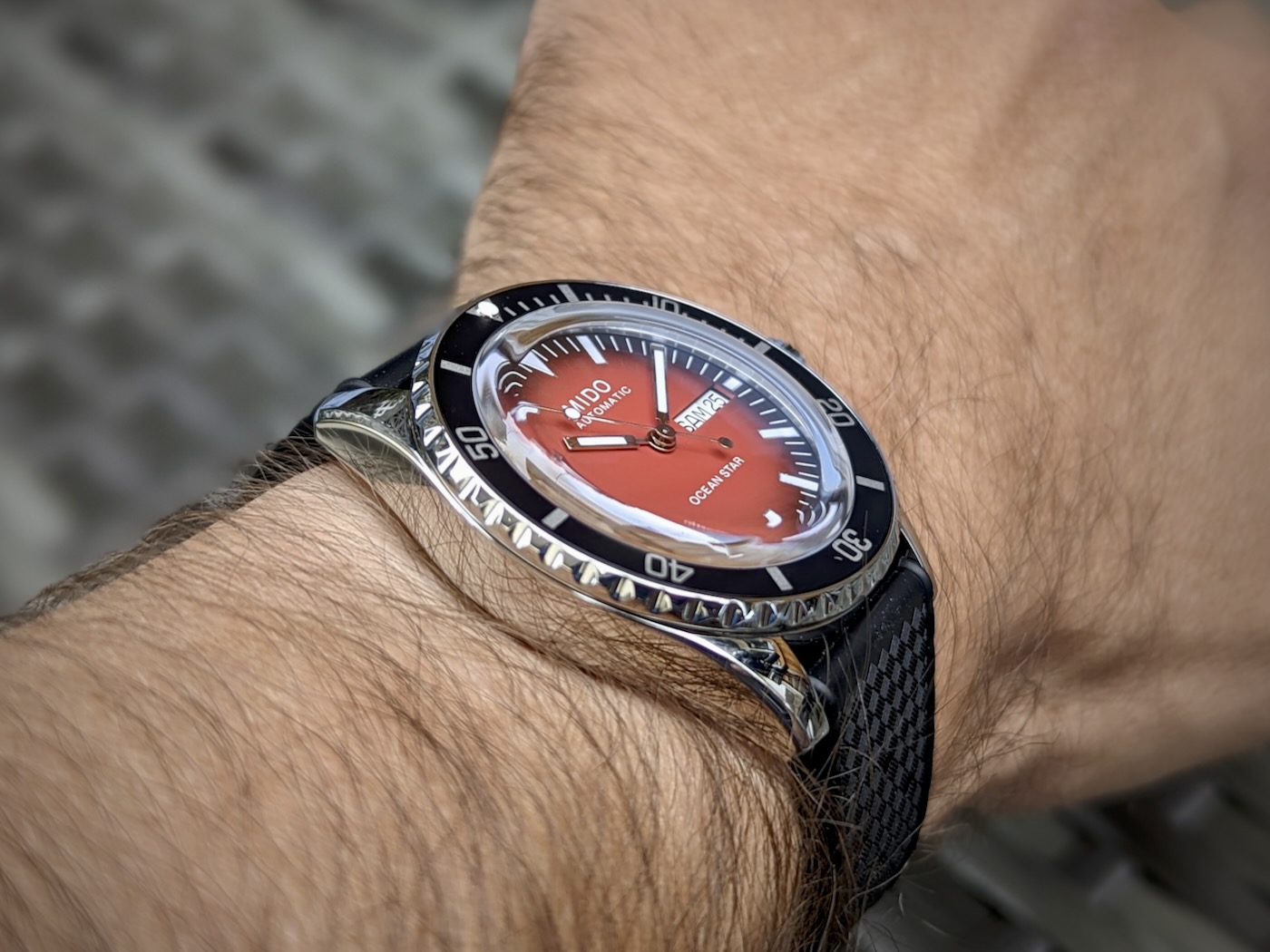
Unlike the other two watches reviewed here, the Tribute Gradient uses a simple, squared-off paddle handset — a good choice, as they’re a better fit for the vintage feel of this watch than the more modern handset found on other watches in the Ocean Star lineup.
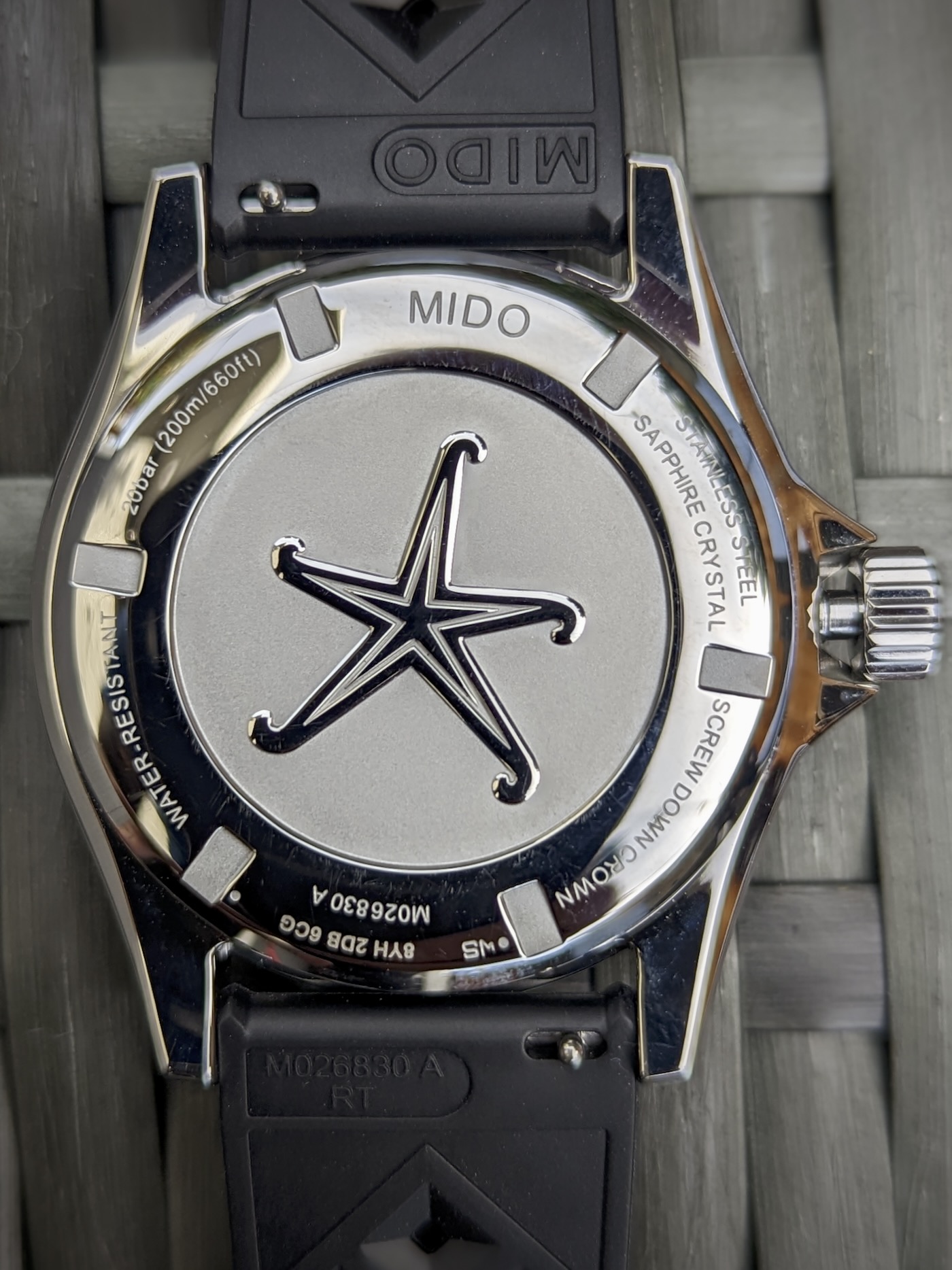
The Tribute Gradient came mounted on a comfortable and pliable 21mm tropic-style strap. The 21mm lug width does make finding different strap options more of a challenge, but Mido offers several strap options, including a very cool fine-link bracelet, all of which are equipped with tool-free spring bars for quickly changing up the look of the watch. If you’re not a fan of the red gradient dial, the Tribute Gradient does also come in a gray gradient with a contrasting orange seconds hand, as well as several non-gradient Tribute models in different dial and case colors.
Ocean Star 200 20th Anniversary Inspired by Architecture
If the Tribute Gradient is the nostalgic sibling, always searching for thrift store gems and restoring vintage cars, then the Inspired by Architecture is the well-coifed sibling with the fresh suit and trim cut. While sharing the same DNA, the look here is more modern and sophisticated. Starting with the case, the Inspired by Architecture is 42.5mm in diameter, ~49mm lug-to-lug, and 11.8mm in height (thanks in part to the flat sapphire crystal). The case is primarily brushed, with only a bit of polish on the chamfers. While the case shape echoes that of the Tribute gradient, physically and visually, the Inspired by Architecture feels larger on the wrist. Part of this is purely down to the dimensions — it is 2mm larger after all — but the other aspect is that the dial is open and clean and the visual size is increased with the addition of the color-matched bezel.
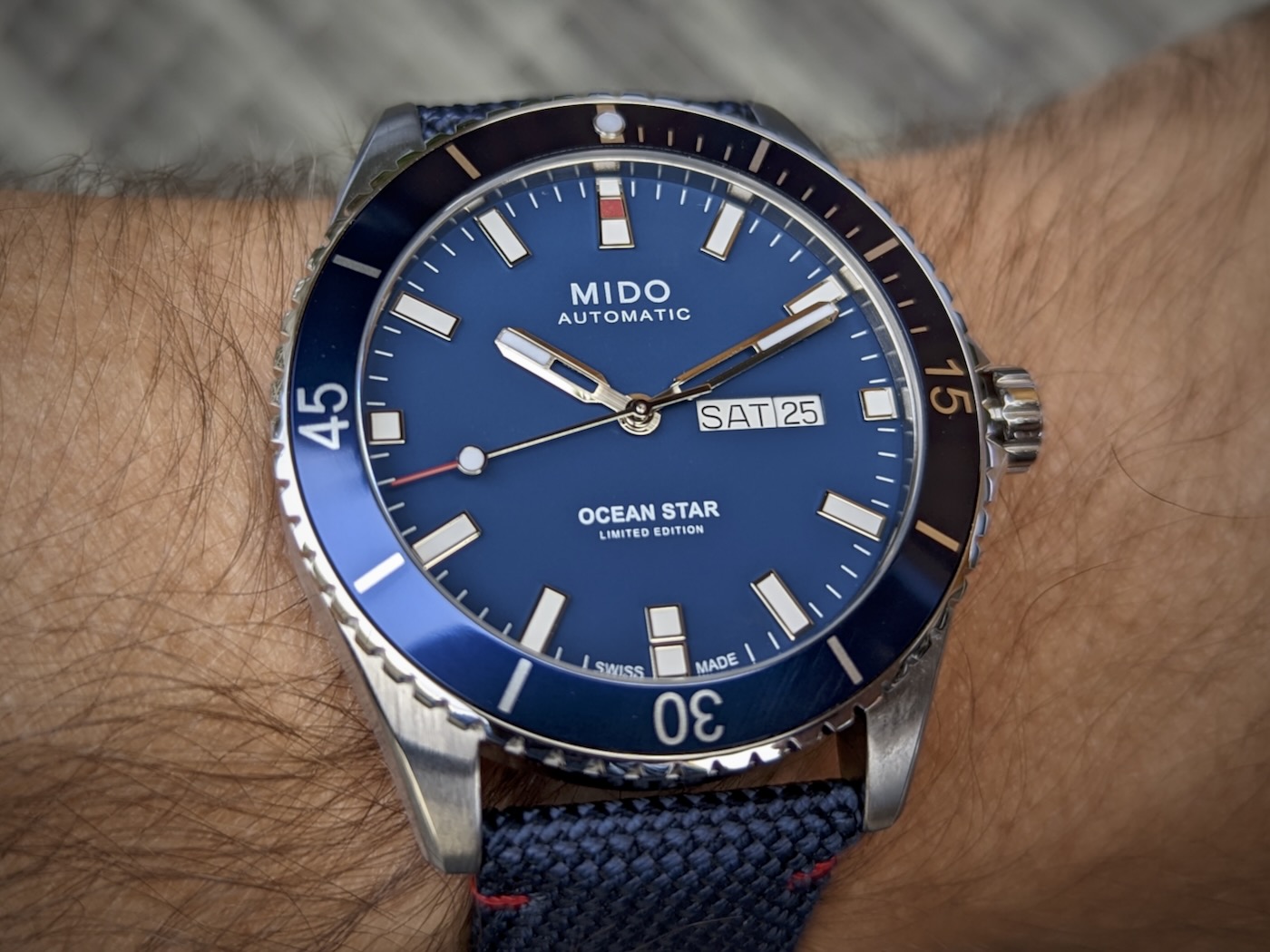 Like the Tribute Gradient, the Inspired by Architecture features applied rectangular indices, but the polished surrounds on the Inspired by Architecture make the watch a bit more versatile and dressy. As mentioned, the handset is more modern on both the Inspired by Architecture and the GMT, skeletonized at the base and filled with Super-LumiNova towards the tips. The handset is attractive and easy to read, and the red seconds hand tip is a nice touch as it plays off the red accent on the 12 o’clock marker. The watch features the same day/date complication found on the Tribute Gradient, so, once again, opinions will be divided.
Like the Tribute Gradient, the Inspired by Architecture features applied rectangular indices, but the polished surrounds on the Inspired by Architecture make the watch a bit more versatile and dressy. As mentioned, the handset is more modern on both the Inspired by Architecture and the GMT, skeletonized at the base and filled with Super-LumiNova towards the tips. The handset is attractive and easy to read, and the red seconds hand tip is a nice touch as it plays off the red accent on the 12 o’clock marker. The watch features the same day/date complication found on the Tribute Gradient, so, once again, opinions will be divided.
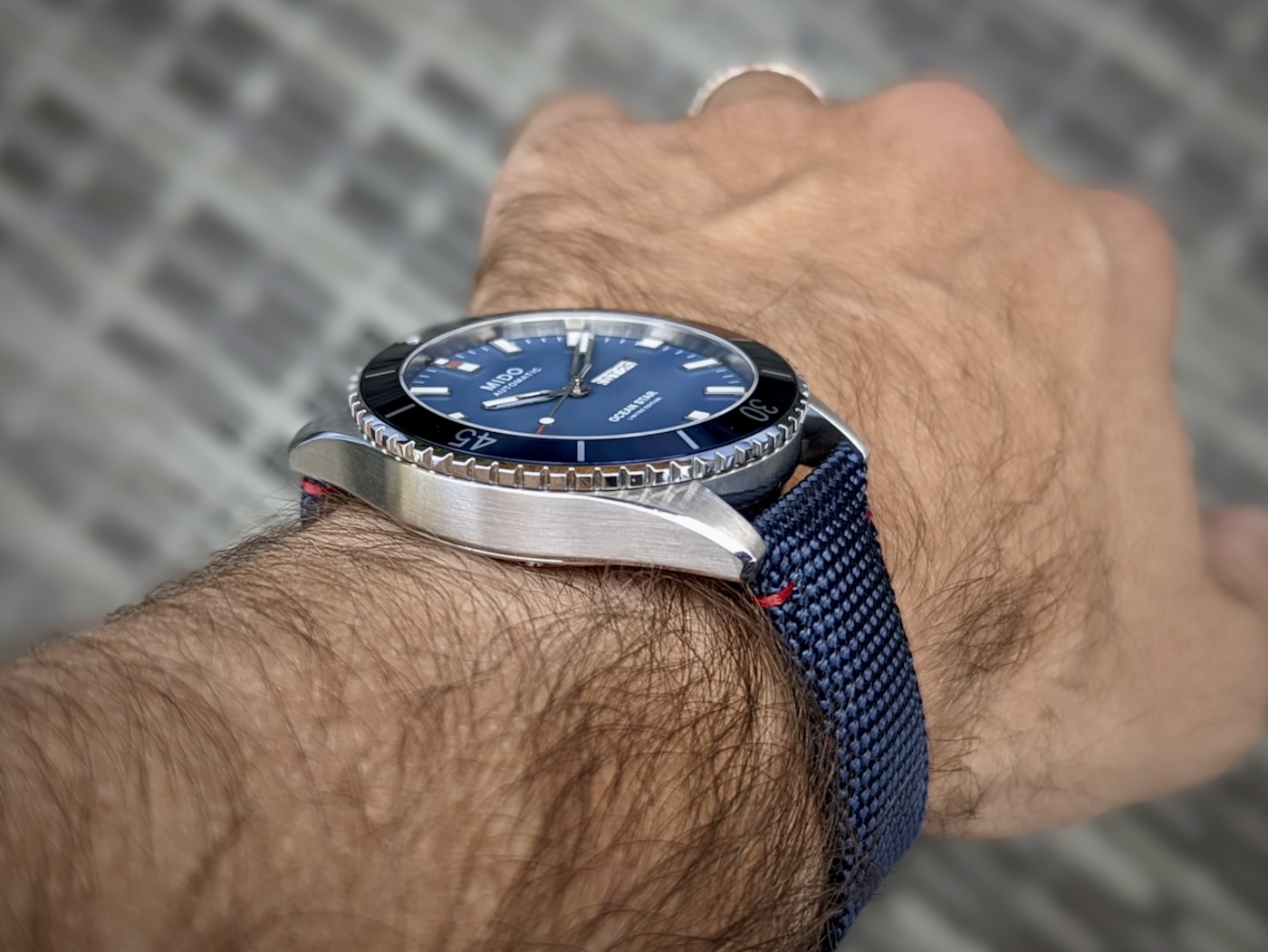 The Inspired by Architecture comes mounted on a 22mm dark blue, leather-backed fabric strap accented with red stitching to match the dial. The strap is a bit stiff out of the box but will undoubtedly break in nicely over time. With a common lug size of 22mm, swapping out the straps is simple to do, and the Ocean Star 200 line also includes a brushed three-link bracelet and fitted rubber strap if those are more to your taste. That said, the fabric strap, with its red accents, is a spot-on aesthetic match and a nice mix between sporty and sophisticated.
The Inspired by Architecture comes mounted on a 22mm dark blue, leather-backed fabric strap accented with red stitching to match the dial. The strap is a bit stiff out of the box but will undoubtedly break in nicely over time. With a common lug size of 22mm, swapping out the straps is simple to do, and the Ocean Star 200 line also includes a brushed three-link bracelet and fitted rubber strap if those are more to your taste. That said, the fabric strap, with its red accents, is a spot-on aesthetic match and a nice mix between sporty and sophisticated.
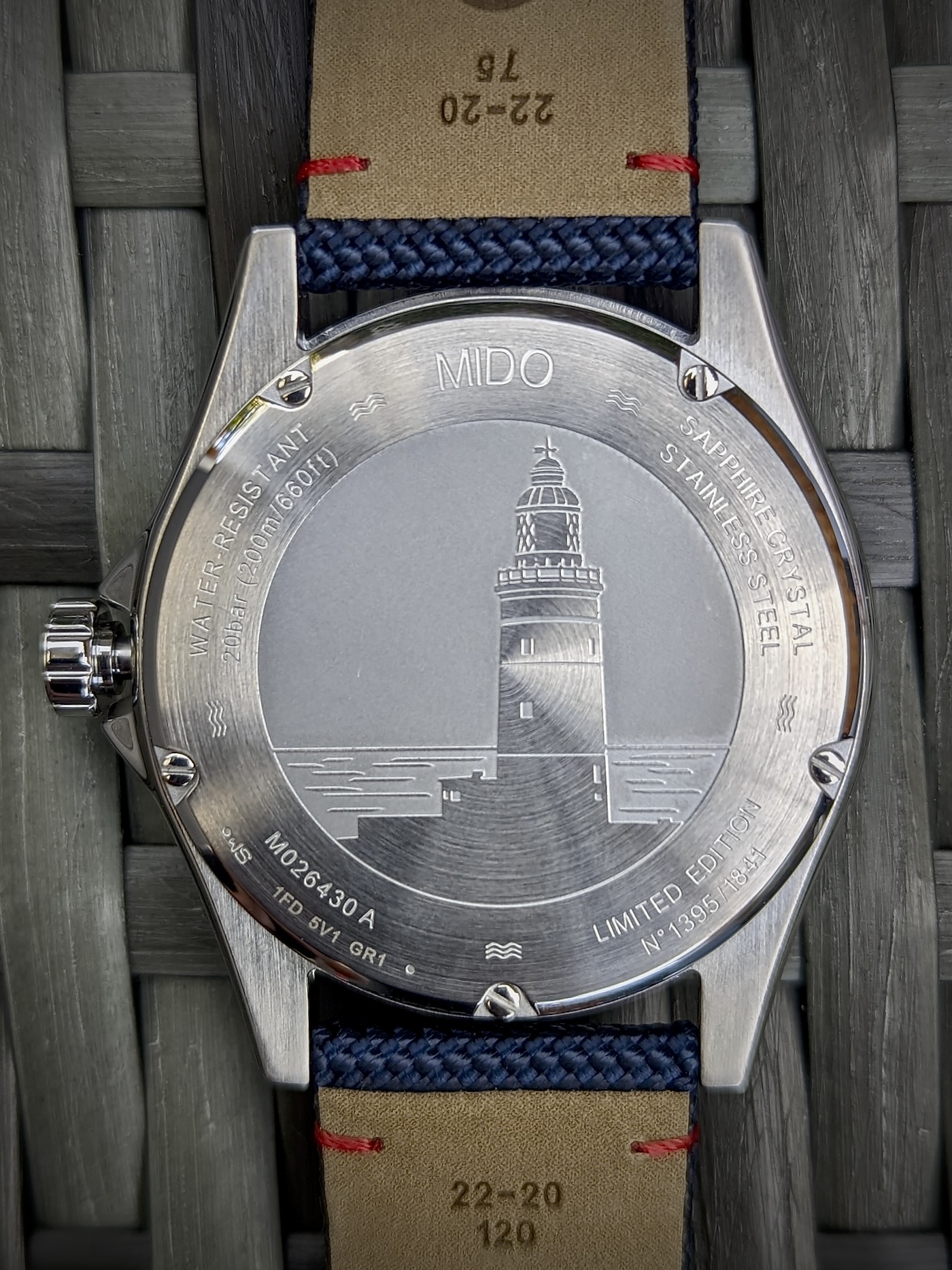 As part of Swatch group, Mido has access to ETA’s wide range of calibers. Both the Tribute Gradient and 20th Anniversary Inspired by Architecture watches are powered by the Mido Caliber 80, based on the ETA C07.621. This automatic movement features a day/date function, 25 jewels, and most importantly, a robust 80-hour power reserve. As most watches in this price range are equipped with movements like the Sellita SW200-1 (or ETA 2824-2), which features ~40 hours of power reserve, the 80 hours on tap is impressive and more than welcome if you’re the type to swap watches throughout the week.
As part of Swatch group, Mido has access to ETA’s wide range of calibers. Both the Tribute Gradient and 20th Anniversary Inspired by Architecture watches are powered by the Mido Caliber 80, based on the ETA C07.621. This automatic movement features a day/date function, 25 jewels, and most importantly, a robust 80-hour power reserve. As most watches in this price range are equipped with movements like the Sellita SW200-1 (or ETA 2824-2), which features ~40 hours of power reserve, the 80 hours on tap is impressive and more than welcome if you’re the type to swap watches throughout the week.
Ocean Star GMT
To stretch this sibling metaphor on the rack just a wee bit further, let’s consider the GMT the older, more mature brother that’s still fit and active, but frequently travels for work. “Brother” is more fitting than the generalized “sibling” in this case, given that the GMT has a more aggressive, masculine aesthetic than either the Tribute Gradient or the Inspired by Architecture. This is due in part to the watch’s dimensions, which come in at 44mm in diameter, 50mm lug-to-lug, and 13.3mm-thick. You get the same case shape as the other Ocean Star watches in the line, with same brushed and polished finishing found on the Inspired by Architecture. In a nice touch, the caseback features a quick guide to time zones across the world.
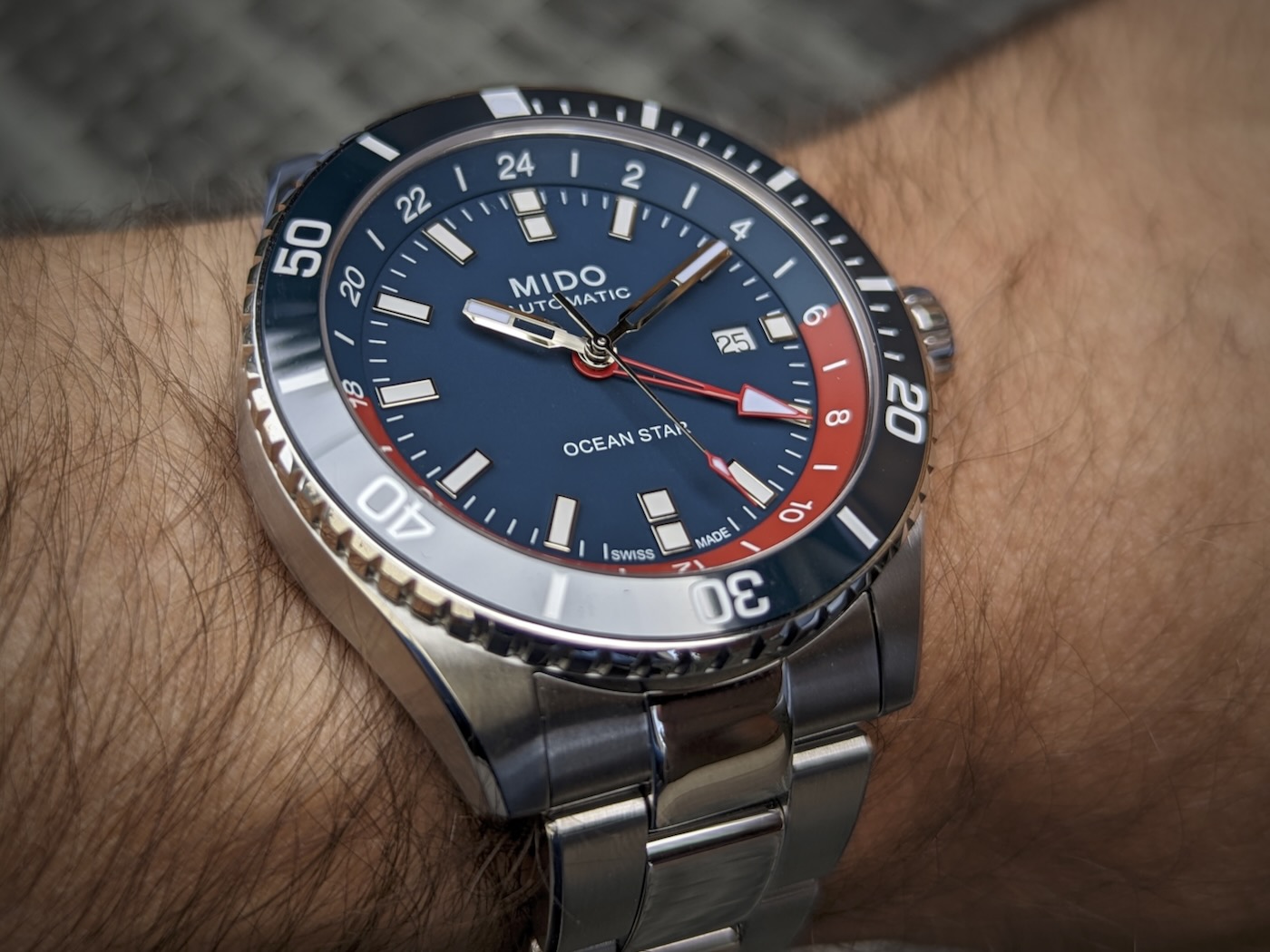 The GMT is a clear evolution of the Ocean Star 200, sharing many of the same design elements, including the hands and indices, though of course, the GMT has a fourth hand, the GMT hand. The GMT hand is red and skeletonized with a luminous, triangular tip. It’s a nice execution of a GMT hand, as it is unobtrusive yet easy to read at a glance. There are plenty of ways to execute a GMT function, but Mido has chosen to keep diving at the forefront (this is an Ocean Star, after all), using a full, 120-click dive bezel and relegating the two-tone 24-hour scale to the rehaut. The upside to this approach is that you get the full functionality of a dive bezel for timing events. The downside is that you only get two time zones, as opposed to three if the watch were coupled with a rotating 24-hour bezel. One approach isn’t necessarily better than the other; it’s just a matter of your use case.
The GMT is a clear evolution of the Ocean Star 200, sharing many of the same design elements, including the hands and indices, though of course, the GMT has a fourth hand, the GMT hand. The GMT hand is red and skeletonized with a luminous, triangular tip. It’s a nice execution of a GMT hand, as it is unobtrusive yet easy to read at a glance. There are plenty of ways to execute a GMT function, but Mido has chosen to keep diving at the forefront (this is an Ocean Star, after all), using a full, 120-click dive bezel and relegating the two-tone 24-hour scale to the rehaut. The upside to this approach is that you get the full functionality of a dive bezel for timing events. The downside is that you only get two time zones, as opposed to three if the watch were coupled with a rotating 24-hour bezel. One approach isn’t necessarily better than the other; it’s just a matter of your use case.
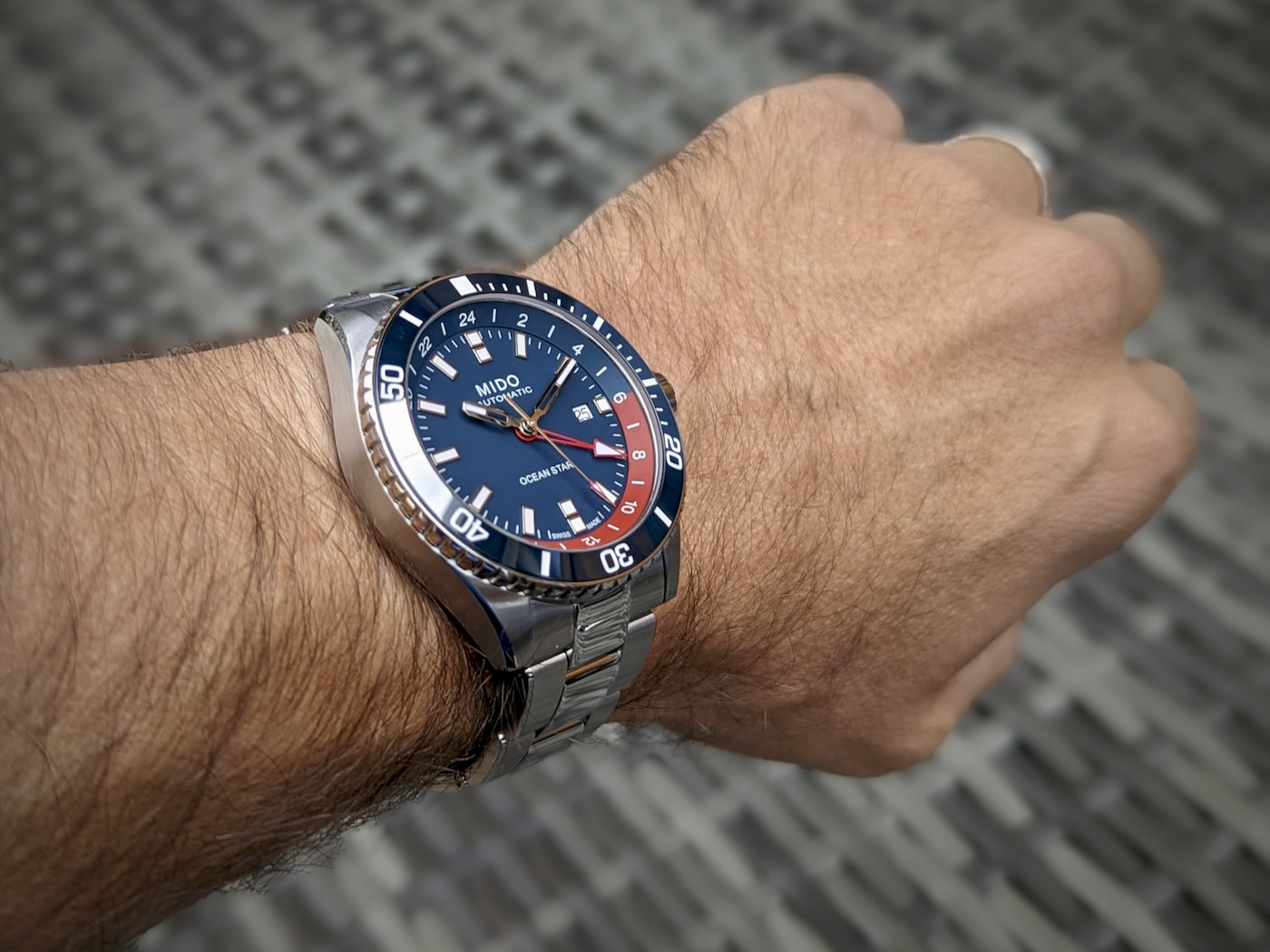 The blue on the dial is a deep navy, offset by the vibrant red on the lower half of the 24-hour ring. The bezel itself is a deeper blue that looks nearly black in low light. Overall, it’s an attractive color scheme. However, if the red accents are a bit too loud for your taste, the GMT is also available in other colorways. The version reviewed here came mounted on a three-link bracelet with brushed outer links and polished center links. Mido secures the bracelet with a push-button clasp that features a tool-free extension. The bracelet is simple, comfortable, and attractive.
The blue on the dial is a deep navy, offset by the vibrant red on the lower half of the 24-hour ring. The bezel itself is a deeper blue that looks nearly black in low light. Overall, it’s an attractive color scheme. However, if the red accents are a bit too loud for your taste, the GMT is also available in other colorways. The version reviewed here came mounted on a three-link bracelet with brushed outer links and polished center links. Mido secures the bracelet with a push-button clasp that features a tool-free extension. The bracelet is simple, comfortable, and attractive.
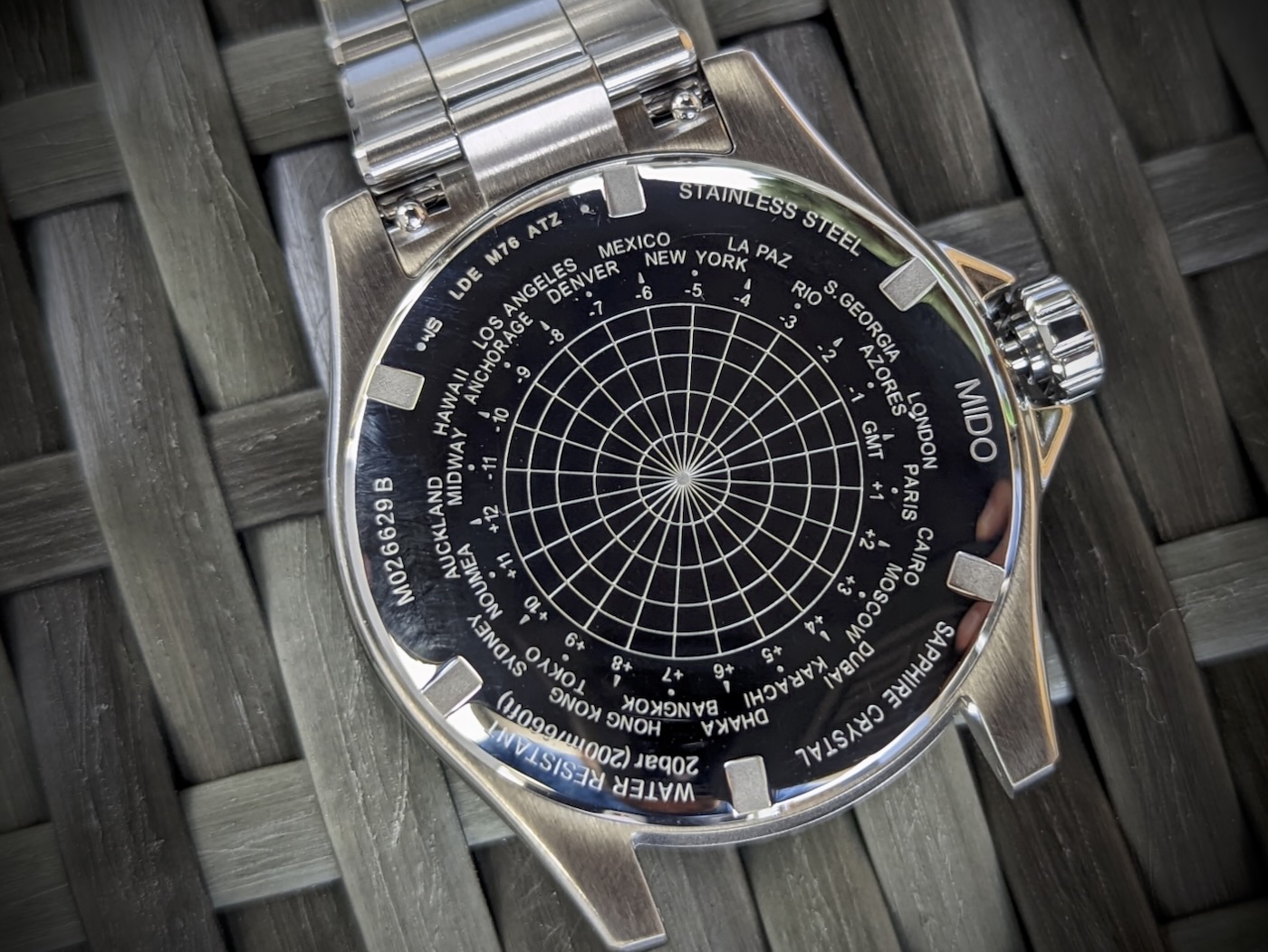 Given that it’s a GMT watch, the Ocean Star GMT necessitates a different caliber. In this case, the Ocean Star GMT again uses a Caliber 80, but this version is based on the ETA C07.661 (a bit confusing that Mido uses the same name for both calibers). This movement features GMT and date functionality, 25 jewels, and that same 80 hours of power reserve. Importantly, this is a “true” GMT movement, meaning that you get a jump hour hand that allows you to quickly change the local time without hacking the watch or changing the GMT hand.
Given that it’s a GMT watch, the Ocean Star GMT necessitates a different caliber. In this case, the Ocean Star GMT again uses a Caliber 80, but this version is based on the ETA C07.661 (a bit confusing that Mido uses the same name for both calibers). This movement features GMT and date functionality, 25 jewels, and that same 80 hours of power reserve. Importantly, this is a “true” GMT movement, meaning that you get a jump hour hand that allows you to quickly change the local time without hacking the watch or changing the GMT hand.
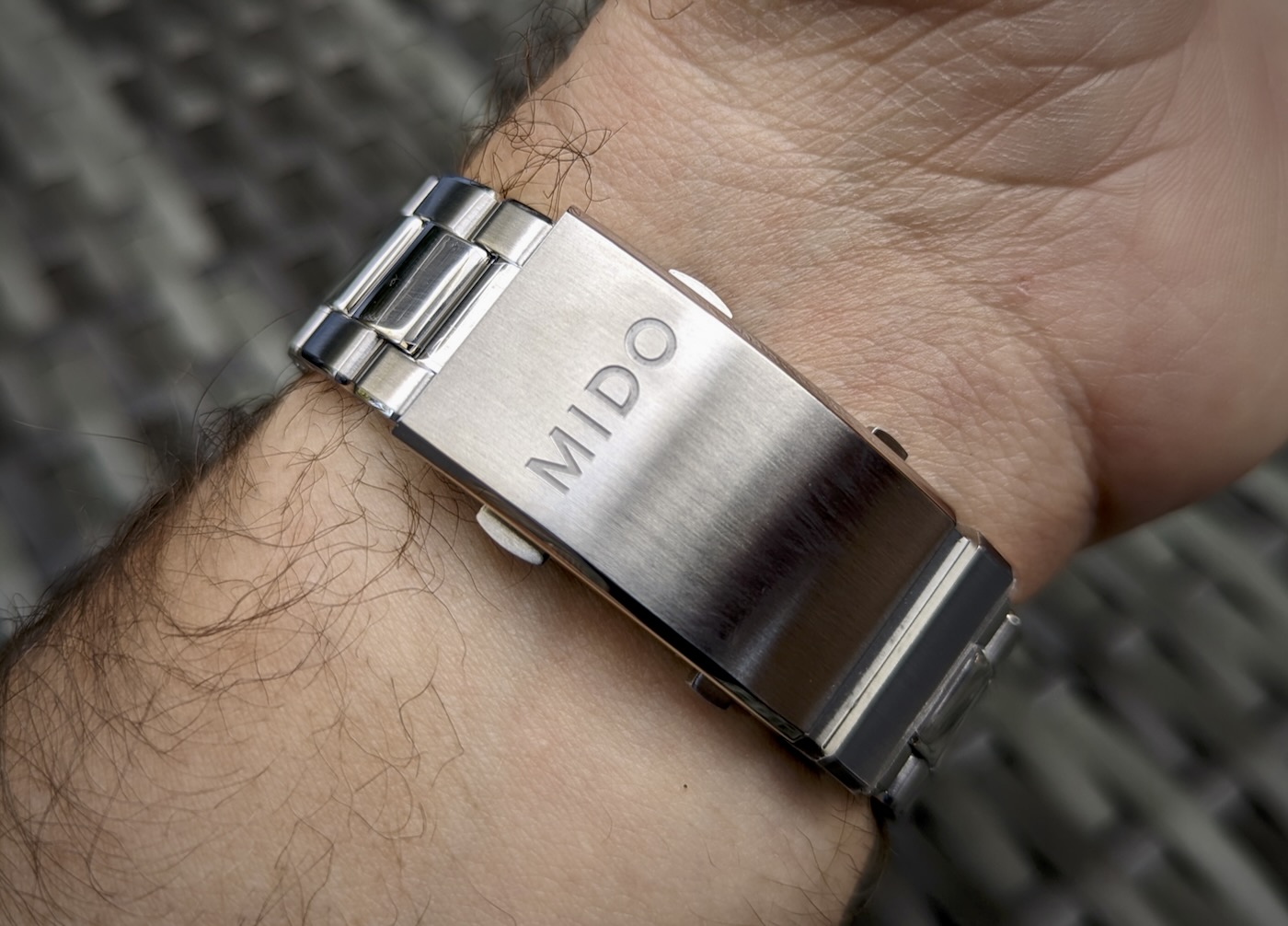 Though each of the watches in the Ocean Star line share plenty of similarities, the wearing experience — and likely the target consumer — of each is quite different. The Tribute Gradient line (starting at $950 USD) has classic vintage styling and a fun and quirky dial: a great pick for a summer watch. The Tribute Gradient’s modest dimensions will fit most comfortably on those with smaller wrists (mine is 6.75”). The Tribute Gradient is likely the least versatile of the bunch, but arguably the most comfortable and fun to wear.
Though each of the watches in the Ocean Star line share plenty of similarities, the wearing experience — and likely the target consumer — of each is quite different. The Tribute Gradient line (starting at $950 USD) has classic vintage styling and a fun and quirky dial: a great pick for a summer watch. The Tribute Gradient’s modest dimensions will fit most comfortably on those with smaller wrists (mine is 6.75”). The Tribute Gradient is likely the least versatile of the bunch, but arguably the most comfortable and fun to wear.
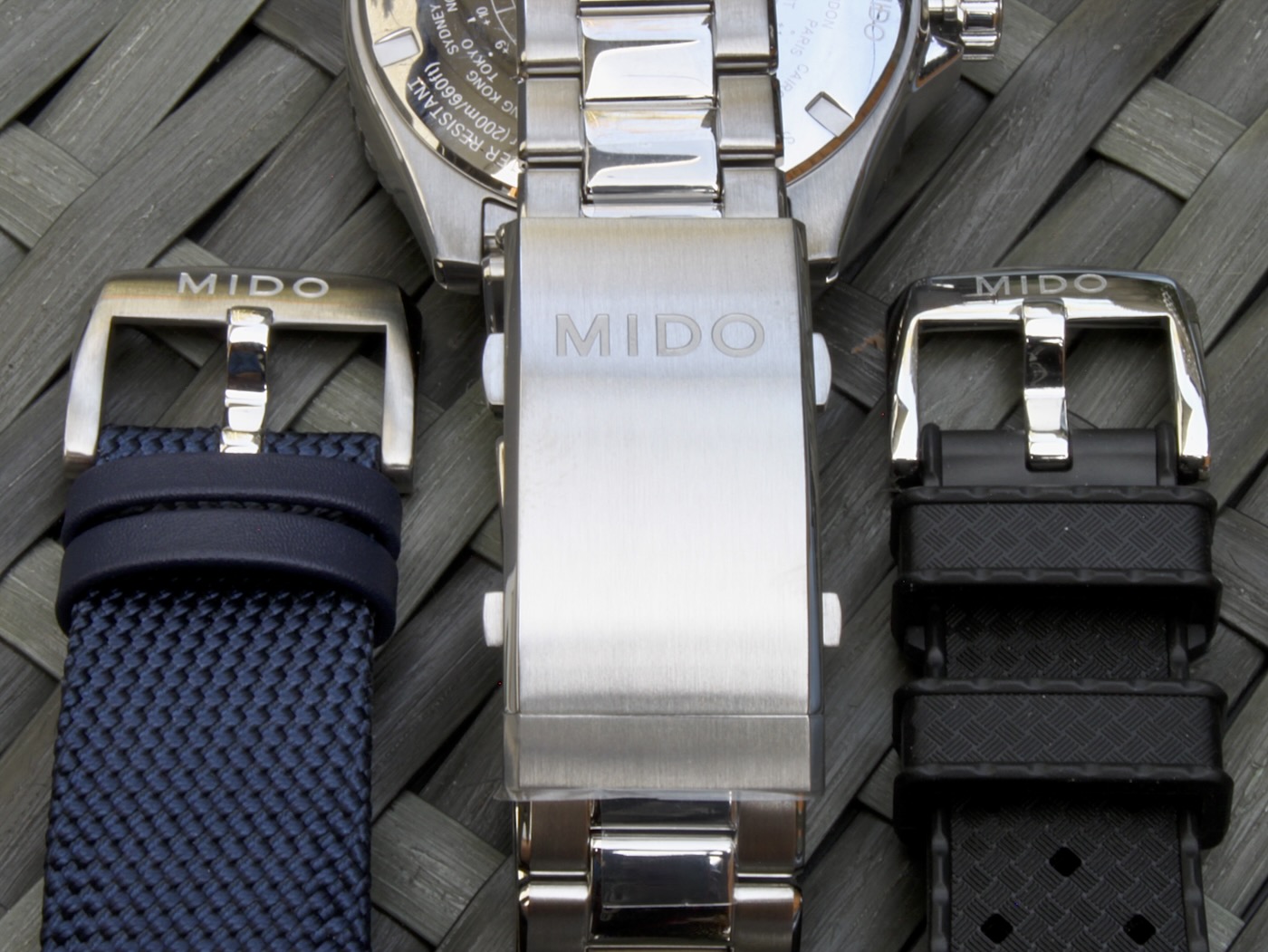 The Inspired by Architecture is easily the most conservative watch of the bunch, but also the most versatile if you’re looking for a single watch to wear every day. Conservative, versatile design is no bad thing, especially if you’re looking for a daily wear. If you like the look of the Inspired by Architecture but are seeking something a bit more adventurous, there are plenty of other colorways and case materials, including titanium, in the Ocean Star 200 line, with prices starting at $890 USD ($1,170 USD for the Inspired by Architecture reviewed here).
The Inspired by Architecture is easily the most conservative watch of the bunch, but also the most versatile if you’re looking for a single watch to wear every day. Conservative, versatile design is no bad thing, especially if you’re looking for a daily wear. If you like the look of the Inspired by Architecture but are seeking something a bit more adventurous, there are plenty of other colorways and case materials, including titanium, in the Ocean Star 200 line, with prices starting at $890 USD ($1,170 USD for the Inspired by Architecture reviewed here).
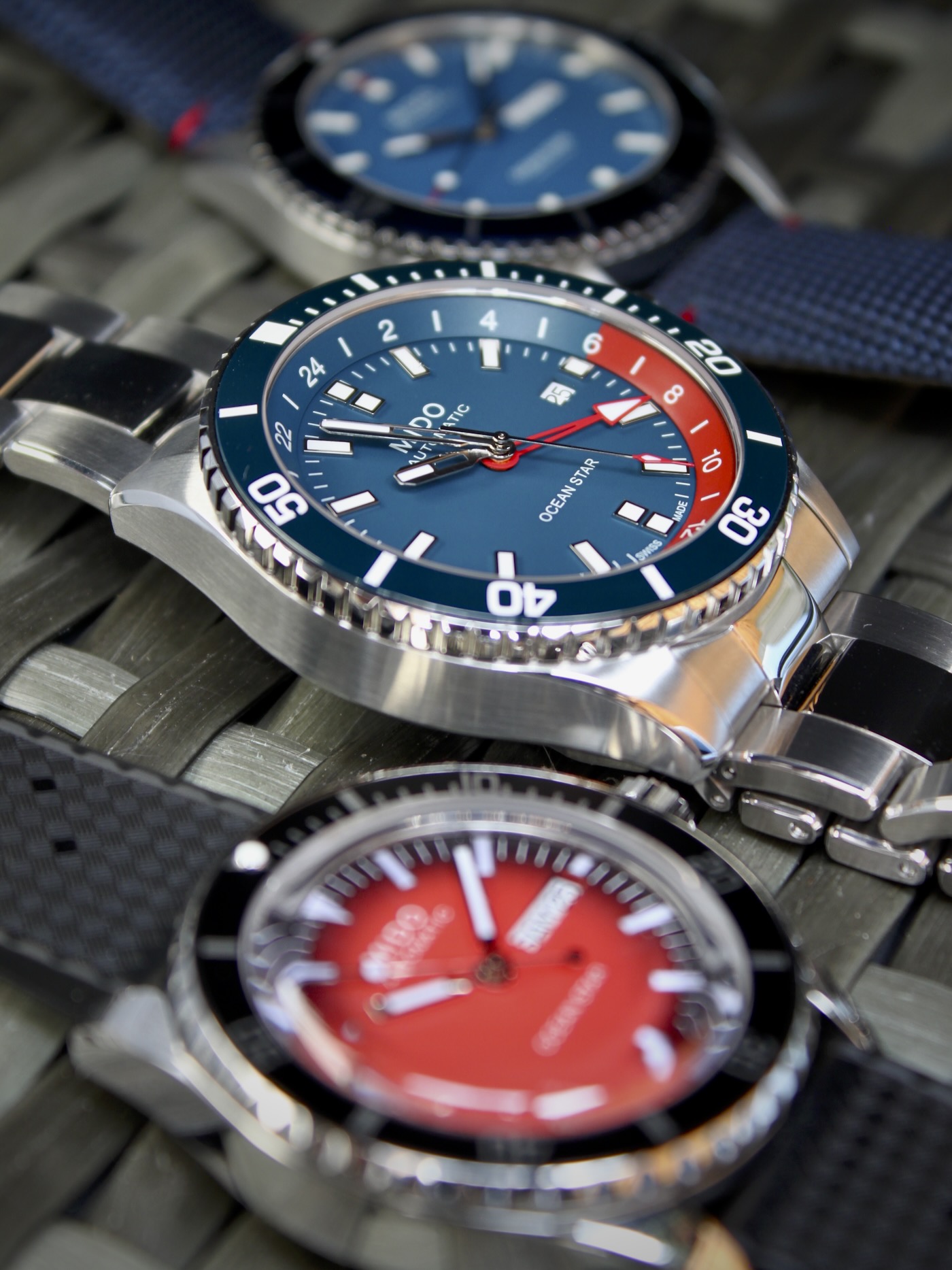
The GMT complication is one of the most useful complications out there, especially for frequent travelers, and the fact that Mido is offering a true GMT watch starting at $1,190 USD, is truly impressive — and shows the power of belonging to the behemoth that is the Swatch Group. That said, the GMT is a large and relatively heavy watch, so its dimensions won’t suit everyone. If the GMT fits your wrist and you’re keen on the look, it does present an excellent value. To learn more about these watches and the myriad others offered within the Ocean Star collection, please visit the brand’s website.
Necessary Data
>Brand: Mido
>Model: Ocean Star Tribute Gradient
>Price: $950 USD
>Size: 40.5mm diameter, 47mm lug-to-lug, 13.4mm thickness, 21mm lug width.
>When reviewer would personally wear it: When looking for a watch with some color and personality.
>Friend we’d recommend it to first: Someone looking for a vintage-inspired watch with a high-quality build and a unique dial.
>Best characteristic of watch: Lovely gradient dial.
>Worst characteristic of watch: Day complication will turn off some buyers; bezel is slippery and difficult to turn.
>Brand: Mido
>Model: Ocean Star 200 20th Anniversary Inspired by Architecture
>Price: $1,170 USD
>Size: 42.5mm diameter, 49mm lug-to-lug, 11.8mm thickness, 22mm lug width.
>When reviewer would personally wear it: When looking for a versatile diver that I could wear in most situations.
>Friend we’d recommend it to first: Someone looking to buy a quality diver that they plan to wear every day.
>Best characteristic of watch: Slim, comfortable case and attractive handset.
>Worst characteristic of watch: Conservative design is versatile but may be too safe for some buyers.
>Brand: Mido
>Model: Ocean Star GMT
>Price: $1,390 USD
>Size: 44mm diameter, 50mm lug-to-lug, 13.4mm thickness, 22mm lug width.
>When reviewer would personally wear it: When travelling to a location where I plan to spend plenty of time on the beach.
>Friend we’d recommend it to first: Someone looking primarily for a larger dive watch that wants the convenience of GMT functionality.
>Best characteristic of watch: Nicely executed GMT hand and 24-hour ring.
>Worst characteristic of watch: Large size and heavy on bracelet, so won’t work for everyone.

